Leichner (post 1945)
Continue from: Leichner (1910-1945)
By 1945, Leichner had closed down manufacturing everywhere apart from Germany and Britain. After the destruction of the building at Schützenstrasse 31 in Berlin by allied bombing, Leichner was forced to set up shop at Dahlem Rheinbabenalle 9.
Leichner (London)
In 1946, Leichner (London) opened a Make-up Studio at 10 Great Newport Street, London, revived their annual luncheons at the Savoy, and began exporting Leichner products once more, its products returning to the United States in 1947 after a long absence.
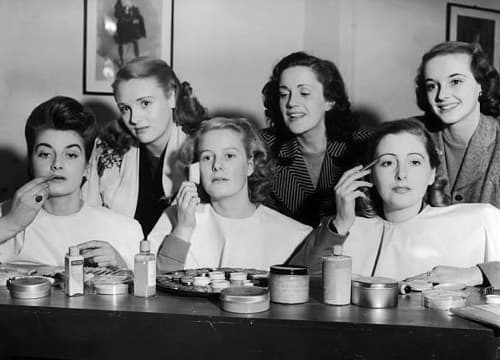
Above: 1946 Lucie Clayton models at a make-up class in the Leichner Make-up Studio in Great Newport Street.
All British cosmetic brands faced serious difficulties after the Second World War with their sales adversely affected by low living standards, high sales taxes and increasing competition from American brands.
A bright spot in the general post-war British malaise of rationing and austerity was the 1951 Festival of Britain. As a part of the festival, a Festival Pleasure Garden was constructed Battersea. Leichner sponsored the Ladies Powder Room there and used it to promote their range of powders, lipsticks and eyeshadows.
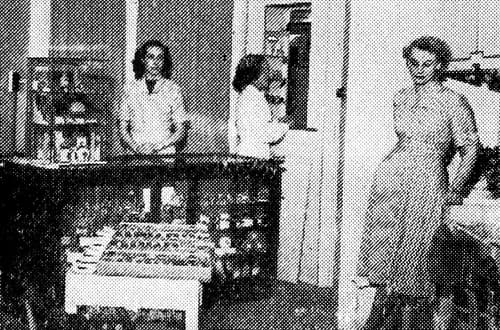
Above: 1951 The Leichner Powder Pavilion staffed by eight young actresses providing make-up advice. The retail counter was operated by W. B. Hubble, chemists.
Professional make-up
Leichner continued to produce make-up for stage, film, television and photography through to the 1960s and beyond. For Leichner (London) this included Stick Greasepaint and Spot-Lite Klear make-up for stage work, Kamera Klear make-up for film, Vision Klear make-up for television, and Colourfilm make-up for photography.
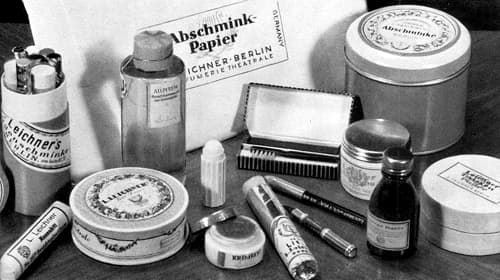
Above: 1951 Leichner professional make-up (West Germany).
To help promote its professional make-up range, Leichner (London) opened the previously mentioned Make-up Studio at 10 Great Newport Street, subsequently moved to 44a Cranbourne Street in 1953. There, professionals and amateurs could get advice from make-up artists on how to select and used Leichner make-up.

Above: 1953 Leichner Make-up Studio in Cranbourne Street.
Stage
Stick and cream greasepaint continued to be the cornerstones of Leichner’s stage make-up, with liquid make-up – either Eau de Lys or Eau de Soie – used for body work.
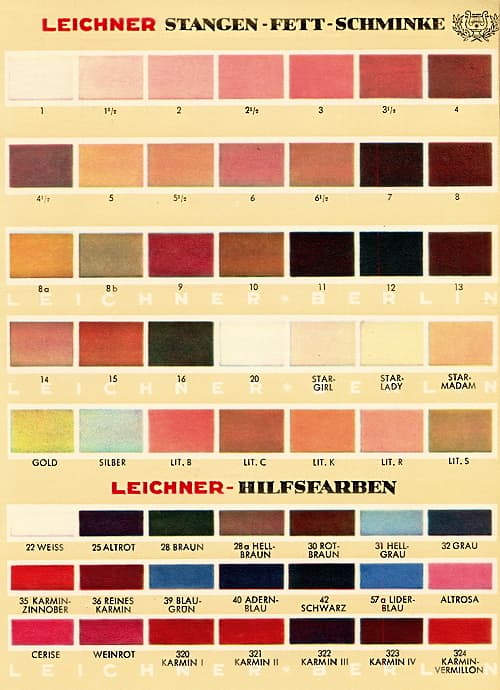
Above: 1951 Greasepaint shades and auxillary colours (West Germany).
As usual, stick greasepaint was worked in with the fingers, while the cream greasepaint, Spot-Lite Klear, was applied with a slightly moist sponge. As before, the stick, cream or liquid make-up was powdered down with Blending Powder or Spot-Lite Finish Powder.
First clean face with Removing Cream; apply Astringent lotion to remove surplus oiliness and counteract perspiration.
Select foundation shade … either stick or tube, apply as thinly as possible, pat well into a perfectly even surface. Apply shadows and highlights; add colour to your cheeks, make up your eyes, and then apply Blending Powder firmly with a Velour Puff. Make up your lips, your eyebrows, apply Eye Cosmetic to your lashes, and liquid make-up to your neck, arms and hands.(‘The art of make-up,’ c.1960, p. 1)
Also see: The Art of Make-up (c.1960)
Along with minor changes to shade ranges there were some additions to Leichner’s liquid body make-up offerings. In 1949, Leichner introduced Island Tan, a cream make-up in large tubes. Released as a general suntan cream, Leichner also recommended it for stage, ballet and television. By 1960, the company had also added Tan Klear, designed only to give the appearance of a tan. By then, Eau de Soie, the creamier version of Eau de Lys liquid make-up that Leichner had introduced in the late 1930s, seems to have been discontinued.
Island Tan: “[P]roduces a glorious tan—protects the skin from sunburn, and permits it to tan naturally.” Shades: Blonde, Brunette, and Summertan with South Pacific added by 1960.
Tan Klear: “[A] clear, coloured liquid body make-up which gives and efficient thin colouring with a slight sheen.” Shades: Suntan Light, and Suntan Dark.
Screen
Leichner Kamera Klear – the British version of the German Allcromo – continued to be recommended by Leichner (London) for film work. By 1949, the company had extended the shade range and it was now available in KK.1, KK.2, KK.3, KK.4, KK.5, KK.6, KK.7, KK.8, KK.9, KK.10, Indian and Sunburn.
In Germany, Allcromo film make-up continued to be developed with cake versions of Allcromo added and shade ranges extended in the 1950s. Unfortunately, I don’t have evidence that Kamera Klear versions of these new Allcromo make-ups were produced in Britain.

Above: 1951 Allcromo shades (West Germany).

Above: 1956 Leichner-Schminken including Allcromo Film make-up.
Television
The Leichner (London) foundation developed for television before the war had its shade range extended to include Kamera Klear Television 1, 2, 3, and 4. By the early 1950s, Leichner had also added Vision Klear for black and white and colour television.
Vision Klear: “[T]he nylon-sheer liquid cream base has been found to give the most satisfactory results for Television productions in Black and White and in colour.” Shades: Television 1, 2, 3, 4, 5, and 6.
General cosmetics
There were some notable developments in the general cosmetics produced by Leichner (London) through to the early 1960s, most of the new additions being in make-up. Describing its products as Fine Cosmetics, like Max Factor, the company tried to associate its make-up with the glamour of film and television.
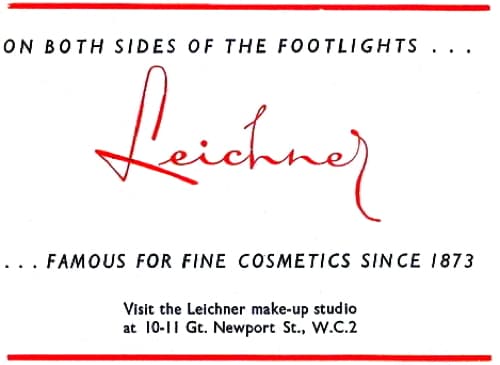
Above: 1946 Leichner ‘Both sides of the footlights’.
Skin-care
All the skin-care cosmetics used before the war continued to be employed through to the 1960s. The only major development that I know of was the extension of the Leichner Facial Pack. In 1958, a cream and lotion was added to the original face mask to create an anti-acne treatment.
Make-up
After the war, new liquid and cream foundations, and pressed powder creams replaced the older, vanishing creams combined with loose and compressed face powders. Leichner responded to these new developments, introducing a number of new foundations in the late 1940s and early 1950s. This included Kamera Klear Base (1947), Flatter Base (1950), and Vision Klear (1952); however, all were hamstrung by limited shade ranges.
Kamera Klear Base: “[T]ransparent, non-drying, and keeps the skin in perfect condition.” Shades: Blonde-Fair, Blonde-Dark, Brunette-Fair, Brunette-Dark.
Flatter Base: “[A] featherlight texture which will not dry your skin and which will remain unchanged all day—a make-up so completely natural that it does not look like make-up at all and does nor require retouching.” Shades: Blonde, and Brunette.
Vision Klear: “[A] soft liquid cream of gossamer lightness. It clings smoothly to your skin and imparts translucent clarity.” Shades: Rose Peach, Sunlit Peach, Blonde, and Brunette.
Strangely, Leichner did not develop a pressed powder cream until 1963 when it introduced Beauty Touch in four shades: Natural Tint, Beige Veil, Tawny Rose and Sun Caress.
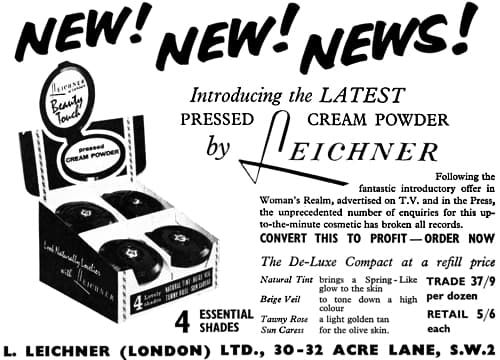
Above: 1963 Industry advertisement for Beauty Touch sold in a black compact case with mirror and puff.
Eye make-up was one area in which Leichner was relatively strong with good shade ranges in its eyeshadows, mascara, eyebrow pencils and eyeliners.

Above: 1955 Display units for Leichner Cream Eyeshadows.
In 1956, Leichner added a Liquid Cream Mascara to its older cake mascara. However, I have no reference to them developing an automatic (wand) mascara in the years after they were introduced by Helena Rubinstein in 1957.
Liquid Cream Mascara: “Easily applied. Makes lashes look long, glossy and keeps them soft and curly. does not clog, does not run, does not smart, waterproof and tear proof. Easily removed.” Shades: Black, Chatain, Dark Brown, Blue, Green, Mauve, Turquoise, Silver, Silver Blue, Silver Green, Silver Mauve and Silver Turquoise. Gold tones added in 1957.
Also see: Automatic Mascara
Leichner added some new lipstick shades after the war – Coral Rose, Crimson Rose, Rose Valerie, Suntan Rose, Peony Rose, Purple Rose, Rose Petunia, Cyclamen Rose, Rose Scarlet, and Peony Rose – but only six of these appear to have been available at any one time.
Also see: Fine Cosmetics for Discerning Women (c.1949) and Easy Steps to Flawless Beauty (c.1957)
Later developments
After Siegfried Leichner died in 1962 the German company was managed by his daughter Mercedes who appears to have picked up an American distributor, Stagelight. Unfortunately, the company’s fortunes were adversely affected by a lengthy legal battle between Mercedes and her mother.
After Mercedes’ death in 1998 the company was to be dissolved but it passed into the hands of the company’s lawyer, Gereon Sandhage instead. Together with his wife Katrina they managed a much reduced company, L. Leichner GmbH Kosmetik through to 2003 when they ceased operations. A former customer of Leichner, Polyco GmbH, based in southern Germany, saved the business and, as far as I can tell, they continue to make and sell a limited range of Leichner professional make-up in Germany.
Leichner (London) did not fair as well. It was sold to Innoxa in 1966 and things looked bright for a while after Innoxa initiated a major refurbishment of the brand and extended its distribution overseas to places like Australia.
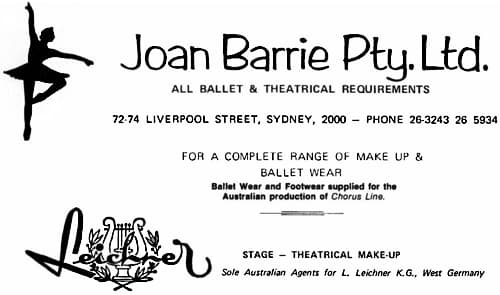
Above: 1977 Joan Barrie agent for Leichner in Sydney, Australia.
Leichner continued to be available in Britain after Innoxa was sold to Globec UK Ltd. in 1989 but, like Innoxa, appears to have been abandoned in the early 1990s.
See also: Innoxa (post 1945)
Timeline
| 1945 | Berlin factory destroyed. |
| 1946 | Make-up Studio opened at 10 Great Newport Street, London. |
| 1947 | Leichner (Buenos Aires) liquidated. New Products (UK): Kamera Klear Base. |
| 1949 | New Products (UK): Island Tan. |
| 1952 | New Products (UK): Vision Klear. |
| 1953 | London Make-up Studio moved to 44a Cranbourne St. |
| 1956 | New Products (UK): Liquid Cream Mascara. |
| 1958 | New Products (UK): Anti-Acne Lotion, Cream and Facial Pack. |
| 1963 | New Products (UK): Beauty Touch. |
| 1966 | Innoxa (England) Ltd. acquires L. Leichner (London) Ltd. |
| 1972 | L. Leichner Pty. Ltd. established in Australia. |
| 1989 | Innoxa (England) Ltd. acquired by Glopec UK Ltd. |
First Posted: 30th September 2020
Last Update: 1st June 2021
Sources
The art of make-up [Booklet]. (c.1960). London: L. Leichner.
Easy steps to flawless beauty [Booklet]. (c.1975). London: L. Leichner.
Fine cosmetics for discerning women [Booklet]. (c.1949). London: L. Leichner.
Kehoe, V. J.-R. (1995). The technique of the professional make-up artist (Rev. ed.). Boston: Focal Press.
Make-up guide for stage – film – photography and television [Booklet]. (c.1955). London: L. Leichner.
Pirchan, E. (1951). Das maskenmachen und schminken: Anleitung zur ausführung von maskierungen. Ravensburg: Verlang Otto Maier.

1946 Leichner (Germany).
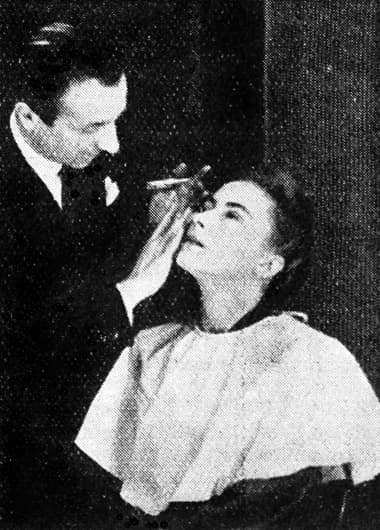
1946 Client receiving a make-up demonstration at the Make-up Studio in Great Newport Street.
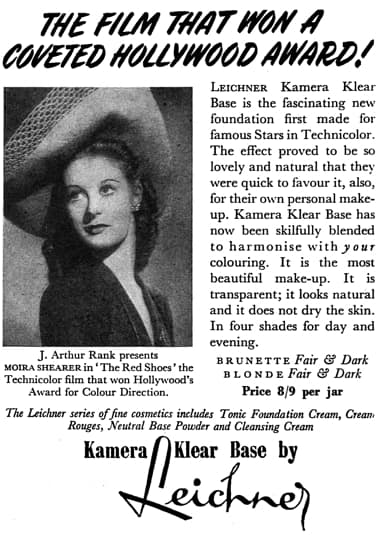
1949 Leichner Kamera Klear Base.
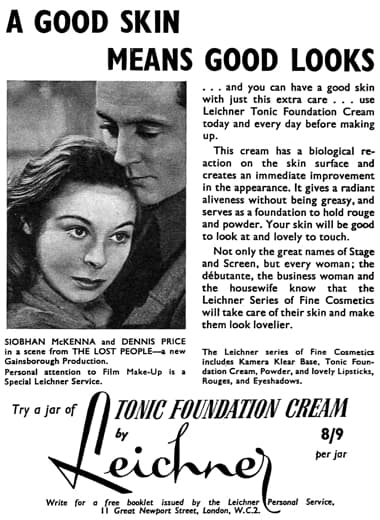
1949 Leichner Tonic foundation.
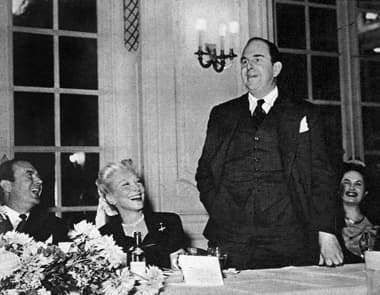
1950 Robert Morley [1908-1992] speaking at a Leichner luncheon at the Savoy Hotel in The Strand.

1950 Leichner Fine Cosmetics.
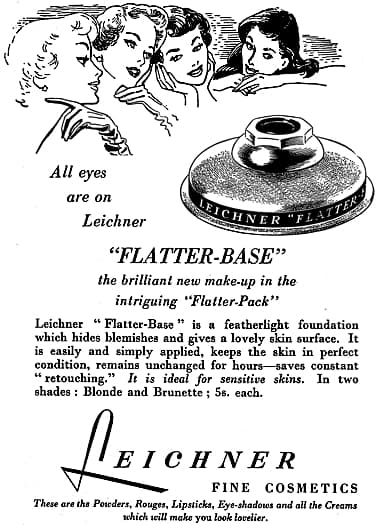
1951 Leichner Flatter Base.
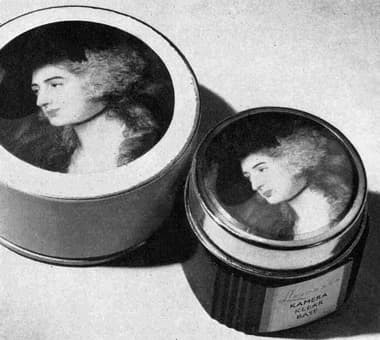
1951 Leichner Kamera Klear Base.
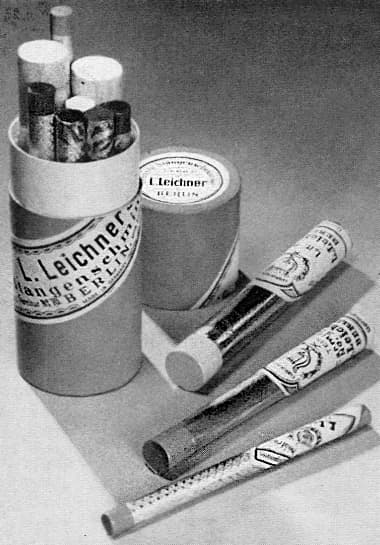
1951 Leichner Greasepaints (West Germany).
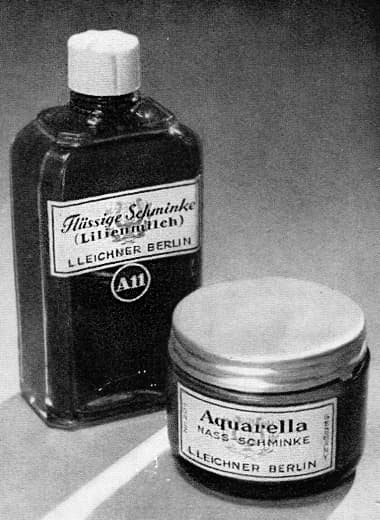
1951 Leichner Professional Liquid Make-up (West Germany).
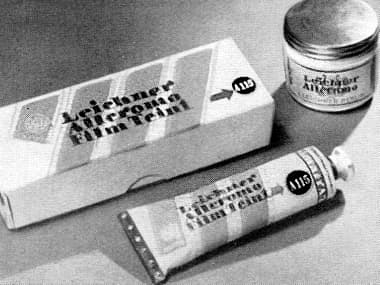
1951 Leichner Allcromo Make-up (West Germany).
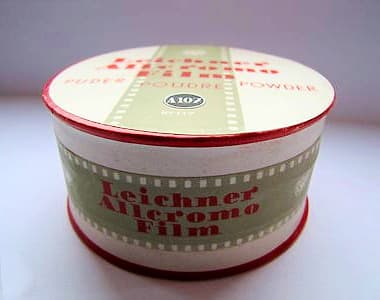
Leichner Allcromo Film Powder.
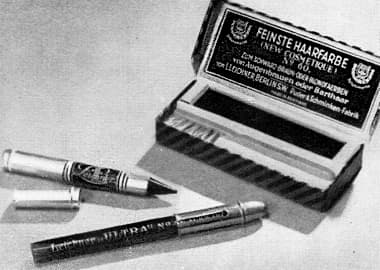
1951 Leichner Professional Eye Make-up (West Germany).
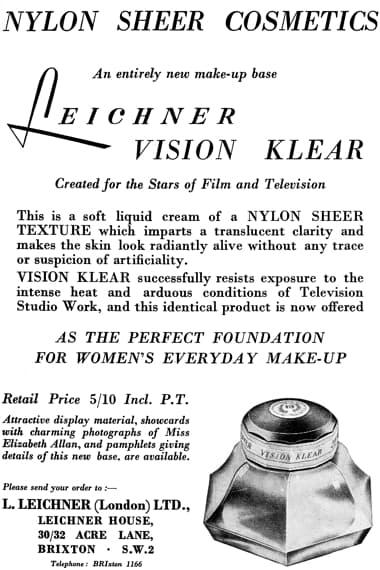
1952 Leichner trade advertisement for Vison Klear.
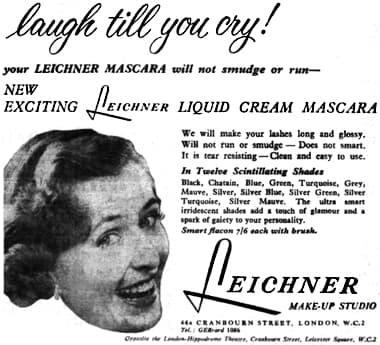
1956 Leichner Cream Mascara.

1957 Leichner Fine Cosmetics.
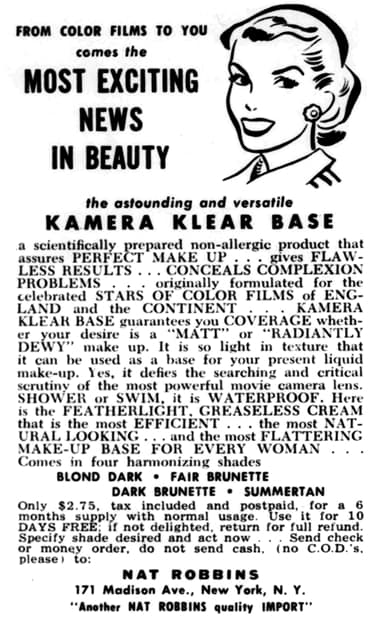
1957 Leichner Kamera Klear (USA).
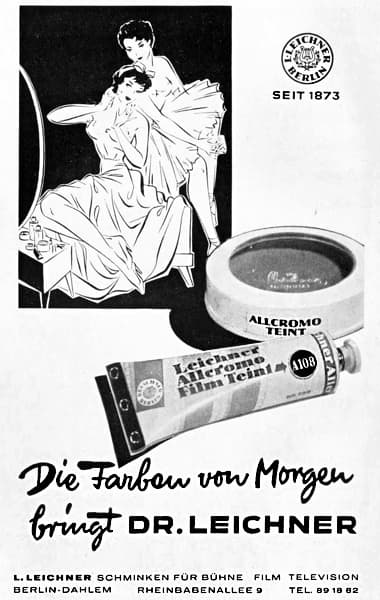
1957 Leichner Allcromo.
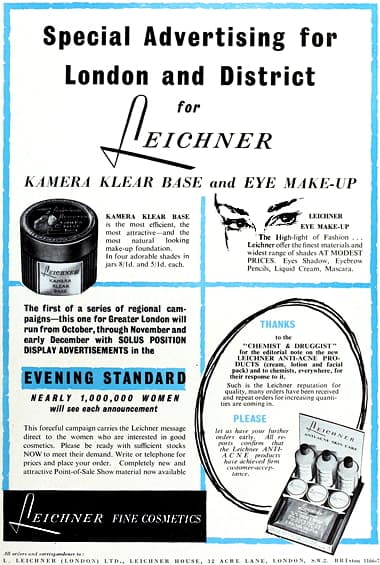
1958 Leichner trade advertisement for Kamera Klear and Leichner eye make-up.

1965 Leichner display stand for Eyebrow Pencils and Lining Brushes.

1973 Leichner cosmetics (Australia).
